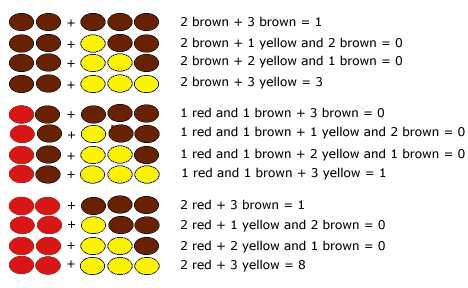Illinois Goals and Standards addressed:
Grade Levels 4-8
Mathematics: Data Analysis and Probability
Goal 10: Collect, organize, and analyze data using statistical methods, predict results, and interpret uncertainty using concepts of probability.
- Standard A: Organize, describe, and make predictions from existing data.
- Late Elementary: 10.A.2c: Make predictions and decisions on data and communicate reasoning.
- Standard C: Determine, describe, and apply the probabilities of events.
- Late Elementary: 10.C.2a: Calculate the probability of a simple event.
- Middle/Junior High: 10.C.3a: Determine the probability and odds of events using fundamental counting principles.
- 10.C.3b: Analyze problem situations (board games, etc,) and make predictions about results.
- Middle/Junior High: 10.C.3a: Determine the probability and odds of events using fundamental counting principles.
- Late Elementary: 10.A.2c: Make predictions and decisions on data and communicate reasoning.
Illinois State Museum Web site used:
MuseumLink Illinois Native American, Historic, The Illinois, Society, Recreation, Plum-stone dice
https://www.museum.state.il.us/muslink/nat_amer/post/htmls/soc_plum.html
Objective: after reading about the game online and playing the game by keeping track of the odds for each throw, students will be able to predict possible outcomes and determine probability of structured events.
Time Required:
5 minutes to read materials and see actual dice on Web site
15 minutes to prepare stones
30 minutes to discuss probability complete Odds chart and
30 minutes to play game
Materials:
one set per each team of
black acrylic paint
white acrylic paint
small brush
jar of water
paper towel
5 plum stones
a bowl or basket
100 small counters such as tooth picks or beans (optional--used if keeping score)
Procedure:
Painting the stones: (one team member paints, the rest verify accuracy)
- Someone has prepared the plum stones by collecting them, washing and scraping them clean, drying them.
- The painter can paint straight from the tube or jar, cleaning brush thoroughly between colors (white first). Two stones are painted black on one side. Three stones are painted white on one side.
- Paint should be dry in 15 minutes.
Discussion can be in math class on probability, using students previous knowledge.
- Explain the situation involved; each simultaneous throw of five stones will yield one of a limited number of outcomes.
- Use the painted stones to throw and have class view outcome 1. The Odds Chart can be used here for the class to look at together, or later as an assessment tool.
- Students should be aware that there are 12 different outcomes possible, the odds are 1 in 12 of any one outcome, and the different odds of scoring 8, 3, 1, and 0 points.
Playing the game should be limited to 15 - 30 minutes per team of 2-4 members.
- Students should be predicting the odds orally to each other for practice as they play.
- Teacher can assess progress by asking questions of various members as to their odds on the next throw of an outcome.
Scoring is optional, but may add incentive to stay on task.
- Players decide on a goal of points; the first player or team to reach the goal 'wins' (It might be worthwhile to have a rule that the winners must be able to reiterate the odds of various scores orally to be declared the winner, or they will default)
Assessment:
If this activity is part of a unit on probability, questions about it could be included on a quiz. If the activity is interdisciplinary for social studies, the Odds Chart could be used again as a culminating assessment.
Extension Activities:
See other web sites and books for similar games to predict odds with different rules of scoring and numbers of dice.
https://www.nativetech.org/games/bowl.html
Odds chart
Look at the scoring chart as you play. Predict the probability of the point-scoring combinations you want to score.
There are two groups of dice:
Dice 1 and 2 (black on one side, natural on the other side)
Dice 3,4, and 5 (white on one side, natural on the other side)All dice are thrown at the same time.
Out of the 12 possible combinations you can throw, how many earn points?
Changing those odds to percentages, what % chance do you have to score each time?
What are the odds that you will score 8 points on one throw?
Resources:
Culin, Stewart. Games of the North American Indians. University of Nebraska Press, 1992. Vols. 1,2. First published as the 24th Annual Report of the Smithsonian Institution's Bureau of American Ethnology in 1907. (A comprehensive work dividing American Indian games into two classes--games of chance and games of dexterity- with a tabular index to tribes and games. Based on museum collections. 846 p.)
Fletcher, Alice. C. Indian Games and Dances with Native Songs. Reprint of 1915 edition. University of Nebraska Press, 1994.. (Part II of the book describes hazard games, guessing games, and ball games.)
Macfarlan, Allan and Paulette Macfarlan. Handbook of American Indian Games. Dover Publications, Inc., 1985.
Miller, Jay. American indian games. Children's Press, 1997. One of the True Book series. Includes information on sources and listservs on the WWW.
Anderson, Madelyn. North American Indian games. To be published in March 2000.
NativeTech: Native American Technology and Art site includes games and references for various sections of the country
https://www.nativetech.org/links/games.html
